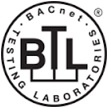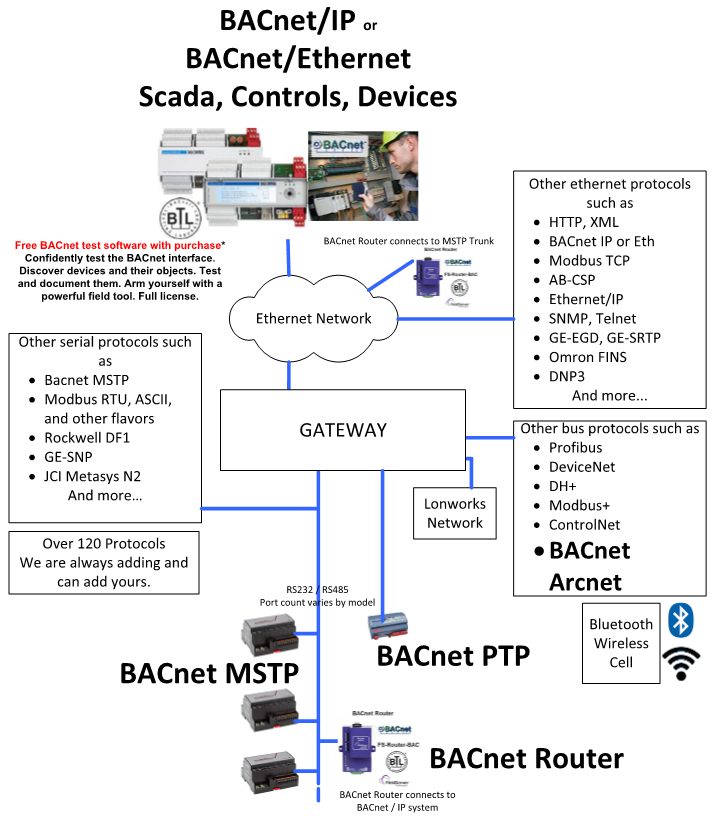BACnet MSTP
The BACnet Master-Slave/Token-Passing (MS/TP) driver implements a data link protocol that uses the services of the RS-485 physical layer. See the FieldServer BACnet PIC statement for the level of conformance that this driver implements.
All information in a BACnet system is represented in terms of objects. The Object_Identifier is a 32-bit code that identifies the type of Object (also identified by the Object_Type Property) and its "Instance" number, which together uniquely identify the Object within its BACnet device. Theoretically, a BACnet device could have over four million Objects of a particular type. The Object_Name is a text string, which has a unique capability. BACnet devices may broadcast queries for devices that contain Objects with a specific Object_Name. This can greatly simplify project setup.
BACnet requires one Device Object to be present in every BACnet device. The Device Object makes information about the device and its capabilities available to other devices on the networks. Before one BACnet device starts control-related communications with another, it needs to obtain some of the information presented by the other device's Device Object. Unlike other Objects, the Device Object's Instance number must be unique across the entire BACnet internetwork because it is used to uniquely identify the BACnet devices. It may be used to conveniently identify the BACnet device from other devices during installation.
Standard object types are used to hold real time data and other information. Each Object Type is referenced by a number, for example 0 represents an Analog Input.
Each Object consists of a number of prescribed properties, the main property being the Present_Value. Objects are monitored and controlled through their properties. The Analog Input Object is representative of the Objects involved directly with control elements and many of its Properties reflect this.
BACnet IP
The BACnet/IP driver allows the FieldServer to transfer data to and from devices over Ethernet using BACnet/IP protocol. The FieldServer can emulate either a Server or Client.
All information in a BACnet system is represented in terms of objects. The Object_Identifier is a 32-bit code that identifies the type of Object (also identified by the Object_Type Property) and its "Instance" number, which together uniquely identify the Object within its BACnet device. Theoretically, a BACnet device could have over four million Objects of a particular type. The Object_Name is a text string, which has a unique capability.
BACnet devices may broadcast queries for devices that contain Objects with a specific Object_Name. This can greatly simplify project setup.
Every BACnet device must have a Device Object, which provides details about the device and its functionalities to other networked devices. Before engaging in control communications, a BACnet device must acquire pertinent information from the Device Object of the target device. Unlike other Objects, the Instance number of the Device Object must be unique across the entire BACnet internetwork, serving as the device's distinct identifier. This uniqueness facilitates easy identification of the BACnet device during installation and operation.
Standard object types are used to hold real time data and other information. Each Object Type is referenced by a number, for example 0 represents an Analog Input. See Appendix D.1 for abbreviation list.
Each Object consists of a number of prescribed properties, the main property being the Present_Value. Objects are monitored and controlled through their properties.
BACnet Router
The FieldServer BACnet Router offers a complete BACnet Internetworking solution for BACnet/IP, BACnet Ethernet, and BACnet MS/TP networks with BBMD capabilities.
This is the first standalone BACnet Router and BBMD device that has been certified by BTL to ensure the highest standard for BACnet integration.
The FieldServer BACnet Router has two RS-485 ports enabling up to 64 BACnet MS/TP devices to be connected to it without the use of additional line drivers. Relative to a single port router, the dual-port router halves device response time by distributing devices over the two RS-485 ports.
The FieldServer BACnet Router has an easy one-page configuration, greatly simplifying the installation process. Included in the BACnet Router the BACnet Explorer, allows the integrator to push a button and discover all the BACnet devices connected to the router, greatly simplifying the commissioning process and troubling the BACnet network.
Why and When to Use a BACnet Router
Why?
- To reduce installation costs
- To reduce MS/TP latency
- To have a transparent BACnet network from a single workstation
When?
- Cost of installation is an issue
- Installation time and cabling
- Additional Controllers
- Current BACnet/IP infrastructure is installed
- Ethernet drops are available
Multiple BACnet Routing Connections
- BACnet IP and BACnet MSTP
- BACnet IP and BACnet IP
- BACnet IP and BACnet Ethernet
- BACnet MSTP and BACnet MSTP
- BACnet MSTP and BACnet Ethernet
Ease of Use
- BACnet Explorer: discovers devices connected to the FieldServer BACnet Router.
- BACnet Broadcast Management Device (BBMD) for a connection between different subnets, up to 50 devices supported on the Broadcast Distribution Table (BDT).
- Web-Based configuration with no additional software needed for configuration.
- NAT support with secondary BACnet/IP connection for routing between public and private IP networks.
- Foreign Device Registration (FDR), exposing up to 147 devices details on different subnets.
- SMC Cloud registration connects your devices to the cloud, allowing secure remote access for diagnostics, monitoring, alarming and configuration.
- Onboard diagnostics allow easy troubleshooting for both serial and Ethernet communications.
Ease of Installation
- MDIX to use any Ethernet cable for commissioning and installation.
- DHCP to automatically obtain the IP setting from the network.
- Software “ToolBox” to find and diagnose all FieldServer BACnet routers on the network.
- A wide range of input power requirements, AC or DC.
BACnet Ethernet
The BACnet®1suite of drivers is designed to workwith the FieldServer products. One or more driversusing different Data Link Layer options could beconfigured to act as a gateway between BACnetsystems and RTU, SCADA's and PLC’s using a widevariety of protocols.
This is relevant to the following FieldServerDrivers:
- FS-8700-16 BACnet/PTP
- FS-8700-73 BACnet/MSTP
- FS-8700-07 BACnet/ARCnet
- FS-8704-06 BACnet/IP
- FS-8704-02 BACnet/Ethernet
Specifications
Environment
- Operating temperature: -20 to 70C (-4 to 158F)
- Relative humidity: 10-95% RH non-condensing
Power Requirements
- Input: 24VAC 0.125A, 12-24VDC 0.25A @12 VDC
- Power max: 3W
Other
- Web configuration
- On-board diagnostics
- DIN rail mount included
Communication
Serial (Galvanic Isolation):
- 2 x RS-485
- Baud: 9600, 19200, 34800, 57600, 76800
Ethernet
- 10/100BaseT
- MDIX
- DHCP
Dimensions
- Dimensions (HxWxD): 4 x 1.1 x 2.7 in (10.16 x 2.8 x 6.8cm)
- Weight: 0.4 lbs (0.2 Kg)
Approvals
- CE
- FCC: Class B and C part 15
- UL 60950
- IC Canada
- RoSH and WEEE Compliant

Additional Information
BACnet MSTP to IP
A BACnet Router is used to connect MSTP trunks to BACNetIP systems. The router itself is a device on the IP and on the MSTP side. The router can also act as BBMD device allowing messages to cross from one subnet to another.
BACnet BBMD
BACnet messages cannot cross from one subnet to another except under special circumstances.
Most BACnet sequenc es of messages begin with a broadcast called 'who is'. All devices respond with 'I am'. That is how they are discovered. It is also how many system confirm the device is still there.
Broadcasts can't cross routers (they are blocked) and therefore devices on the other side of a router cannot e discovered.
BBMD is the name of the BACNet technology that resolves these issues. The BACNet ROuter sold by CAS provides BBMD services as do all FieldServer BACNet products when configured as clients.
Logos




